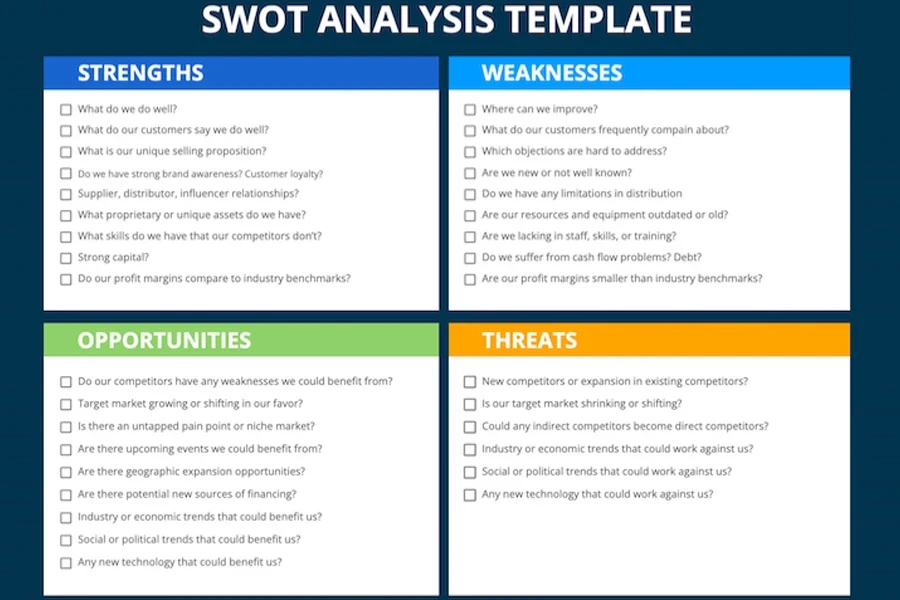Every business needs marketing to be successful. In fact, 75% of CMOs (Chief Marketing Officers) say they measure success with revenue growth. Marketing boosts profits by increasing brand awareness, attracting new customers, and retaining loyal ones.
However, marketing is not a simple, one-time thing. It’s complex and involves strategies across various channels, like email, social media, traditional advertisements, and web content. Hence, it’s no surprise that retailers need a surefire way to group all marketing efforts and ensure each helps pipeline and revenue growth.
Thankfully, that’s where marketing plans come in. This article will explore this crucial plan and how businesses can make the most effective one for their brands in 2024.
Table of Contents
What should businesses add to their marketing plans?
Tips to help create a superb marketing plan in 2024
Free marketing templates businesses can use in 2024
Leverage these tips
What should businesses add to their marketing plans?

Marketing plans contain everything the team wants to achieve over a set period of time. So, naturally, it should include the following components:
1. Business summary
Marketing plans must always have a quick business summary. It’s what stakeholders need to understand about the company before reviewing other parts of the plan. Even when showing long-time employees the marketing plan, the business summary will ensure everyone is on the same page—no one likes objections halfway through the process. Typically, business summaries should have the following elements:
- The business name
- The headquarter’s location
- The mission statement
2. S.W.O.T analysis

Another thing businesses must include in their summary is a SWOT analysis. Why? It shows their strengths, growth opportunities, and potential weaknesses. With this insight, brands can easily create strategies that handle weaknesses while building on strengths.
However, businesses must never rush a SWOT analysis. It needs extreme market research and competitive analysis for 100% accuracy—anything less than that is a waste of time. Even better, companies can check the SWOT analysis frequently and make updates when they get new insights.
3. The business initiative

What’s a marketing plan without a business initiative? A regular document, that’s what. This section is where the marketing departments show their specific goals. Hence, it must never include any broad company-wide goals—leave that for the business plan. Everything in the business initiative must be marketing-specific projects, allowing the team to explain their goals and how they will measure success.
But that’s not all. When the marketing plan has more than one goal, each one should use a SMART (specific, measurable, attainable, relevant, and time-bound) format for better goal setting. For example, instead of using general goals like “Grow Instagram followers,” the SMART option would be “Grow Instagram followers by 30% by June.” The specifics make all the difference.
4. Customer analysis

The marketing team is always researching ways for companies to attract more paying customers and become industry leaders. This section is where they can share everything they have discovered from such market research. However, this process becomes way harder if businesses haven’t done their homework.
Nevertheless, companies must always ensure their data is on point before summarizing it in a marketing plan. Ultimately, the customer analysis section helps show the target niches and their buyer personas.
5. Competitor analysis

Monitoring the competition is not foul play. Businesses must analyze their competitors to see what works and adopt it into their strategies. That’s why competitor analysis is a crucial segment for business plans.
Filling up this section also requires some hefty research. Brands will have to examine their competitors by understanding their strengths and finding weaknesses or gaps to exploit. For example, this analysis can cover the following points:
- Competitors’ positioning
- Competitors’ market share
- Competitors’ successful offerings
- Competitors’ pricing
6. Market strategy
Now it’s getting to the nitty-gritty. The marketing strategy combines the insights from the previous sections to show how companies should approach their target market. For example, if the competitor’s analysis shows they have stronger social media marketing, businesses can develop a strategy to increase their efforts, like “We’ll post 3 times per week on our social media profiles.”
More importantly, the best marketing plans have the “seven Ps” in their market strategy. Experts also call it the extended marketing mix. Here’s what it involves:
- Product
- Price
- Place
- Promotion (the example above falls under this category)
- People
- Process
- Physical evidence
7. Budget

The marketing budget must always be separated from product pricing and other financial details. Hence, this section should show the funds needed for marketing goals. The team can put all their expected expenses, like outsourcing, marketing software, paid promotions, and events, in a list form to make it easier to scan.
With this insight, businesses can plan investments based on the expected ROI and enjoy accurate yearly financial projections. However, the marketing plan should only have a summary of the costs. However, the marketing team can create a different document for the extra details and calculations.
8. Marketing channels

Where would businesses push most of their marketing efforts? This section must include a list of marketing channels brands plan to target. While retailers may use spaces to promote products, marketing channels are where they share helpful content, generate leads, and boost brand awareness.
For instance, brands can add which social networks will have business pages and outline their purpose and how they will measure success. Interestingly, this section will show the higher-ups within and outside the marketing department how these channels will help boost business growth.
9. Marketing technology
Lastly, a marketing plan should include an overview of the tools in the marketing technology (MarTech) stack. These tools help businesses achieve the goals outlined in the previous sections. Since marketing software often requires significant investment, it’s important to link it to potential ROI.
For each tool, describe its purpose and ensure it aligns with the overall strategy. For example, don’t list an advertising management tool if “PPC Advertising” isn’t included under “Marketing Channels.” For marketing analytics software, specify the metrics to be tracked, their importance, and how they will enhance the overall marketing strategy.
Tips to help create a superb marketing plan in 2024
Tip 1: Start by defining the plan

The initial step in creating a marketing plan is to define the mission. While this mission is tailored to the marketing department, it should align with the business’s mission statement. It’s important to be clear, but not overly detailed. Businesses will have enough chances in the marketing plan to explain strategies for gaining new customers and achieving this mission.
For instance, if the business’s mission is “to make booking travel a delightful experience,” the marketing mission could be “to attract travelers, inform them about the tourism industry, and convert them into users of our booking platform.”
Tip 2: Narrow down the key metrics

Now that businesses have the plan, how will they measure its success? That’s where metrics and KPIs come in. Brands must determine the metrics they can track after launching their marketing campaigns. With them, businesses will easily study the performance of all their activities—metrics will also show if the marketing efforts fit the larger business goals.
Although the metrics businesses must track depend on their goals, here are some of the most common ones that have a place in every marketing strategy:
- Reach: It tracks the number of people exposed to marketing efforts, including website visitors, social media followers, and email subscribers.
- Engagement rates: It measures how the audience interacts with the content, such as website clicks, social media shares, and email open rates.
- Conversion rates: It tracks the number of desired actions customers take, like purchases, sign-ups, or downloads.
- Cost-per-lead (CPL): It calculates the average cost of generating new leads through marketing campaigns.
- Return on investment: It measures the financial return that marketing efforts generate.
Tip 3: Keep an eye on the competition

While only focusing on internal operations is common, businesses must also check the competition. Knowing their market strategies helps brands discover new ways to stand out and gain market share. However, retailers must always try to avoid replicating competitors’s efforts.
If a competitor already implements an idea, revisit the drawing board and brainstorm new ways to differentiate. Consumers can easily spot similarities between brands and may not like them. On the bright side, insight from the competitors’ strategies can provide inspiration and show opportunities.
For example, if a competitor launches a similar social media campaign, don’t just copy and paste. Instead, examine the approach and consider how to make the campaign unique while delivering the same message. Also, identify the campaign’s weaknesses and see if it left any unexplored angles.
Tip 4: Define the plan’s team and their responsibilities

With the marketing plan complete, it’s important to clarify team responsibilities. While it’s unnecessary to detail every employee’s daily tasks, businesses must know which teams and leaders are in charge of specific content types, channels, KPIs, and other key areas.
Tip 5: Track performance
Businesses should regularly measure their marketing efforts to identify areas for improvement and optimize in real time. Analyzing data reveals trends, shows which initiatives performed well, and highlights what needs adjustment. These insights can then be used to enhance future marketing plans.
Example: If data shows that long-form content generates 400% more page views than short-form content, businesses should focus on creating more long-form content in their next marketing plan.
Tip 6: Create a timeline

If businesses want to smoothly execute their marketing plan, they must create a marketing plan. It includes all tasks, campaigns, and events with their deadlines, allowing teams to understand what they have to do and when. These timelines may vary, depending on how the brand operates.
However, setting deadlines will involve analyzing tasks and estimating durations while also making space for holidays and events. Plus, tracking similar projects and how long it took to complete them can help increase timeline accuracy.
Free marketing templates businesses can use in 2024
What if businesses don’t want to create their marketing plan from scratch? They can use free templates and fill out the outline with the necessary data. Here are different types of marketing plans linked to a free template from Asana.
- Marketing project plan template
- Agency collaboration template
- Marketing campaign plan template
- Event planning template
- Editorial calendar template
- Creative request template
- Product marketing launch template
- GTM strategy template
Leverage these tips
Businesses can’t start their campaigns without a plan. They must set goals and know how to track their efforts. All these are possible with an effective marketing plan. Businesses can follow the tips and elements included in this document to create a marketing plan from scratch. But if they don’t want the manual hassle, business buyers can use any of the templates provided here, depending on the type of marketing plan they want to make.




